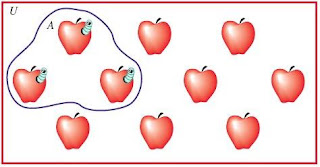- The number 12.345 has 3 decimal places because of 345. the number 12 in front of the decimals is called the integer and the number 345 behind the decimal is in fact the actual decimal.
- Writing out a number in expanded form is as follows: 123.45= 1(100) + 2(10) + 3(1) + 4(1/10) + 5(1/100)
- Given the number 573.9634 what place value does the 9, 6, 3 and 4 have?
6: Hundredths
3: Ones and thousandths
4: Ten thousandths
- 245.639 in written form is: Two hundred forty-five and six hundred thirty-nine thousandths
- 6.4193 in written form is: Six and four thousand one hundred, ninety-three ten thousandths
- The and is the way to separate the integer from the decimal
Tenths- This represents 4/10 or 0.4
Hundredths- This represents 27/100 or 0.27
Thousandths- This represents 463/1000 or 0.463
Base Ten Blocks:
This picture shows 254
1.) If the long is the unit, what number is represented by the drawing? 25.4
2.) If the flat is the unit, what number is represented in the drawing? 2.54
Number Line:
Converting numbers:
- 42/100 = 0.42
- 64193/10000 = 6.4193
- 9/1000 = 0.009
- 436/10 = 43.6
Equality of Decimals: Two decimals are equal if they have the same numbers in the same place values not including extra zeros on the end of the number Ex: 0.7 = 0.70
Inequality of decimals: To write these numbers in increasing order, start with the smallest number in the tenths place and keep going.
- 0.036, 0.19, 0.195, 0.2 is in creasing order.
- 0.190 is less than 0.195
A rational number is any number that can be written in the form a/b where b is not a zero and a and b are integers is called a rational number.
Which of these has a repeating decimal representation?
A. 3/16
B. 3/15
C. 3/10
D. 3/9
E. All of the above
-Not A because it can be written as 3/(2x2x2x2) 0.1875
-Not B because it can be written as 3/(3x5) 0.2
-Not C because it can be written as 3/(2x5) 0.3
- It is D because it is written as 3/(3x3) 0.3 repeating
-Therefore it is not E
- A fraction or rational number can be written as a terminating decimals if the prime factorization of the denominator contains only 2's and or 5's with the fraction in lowest terms.





















